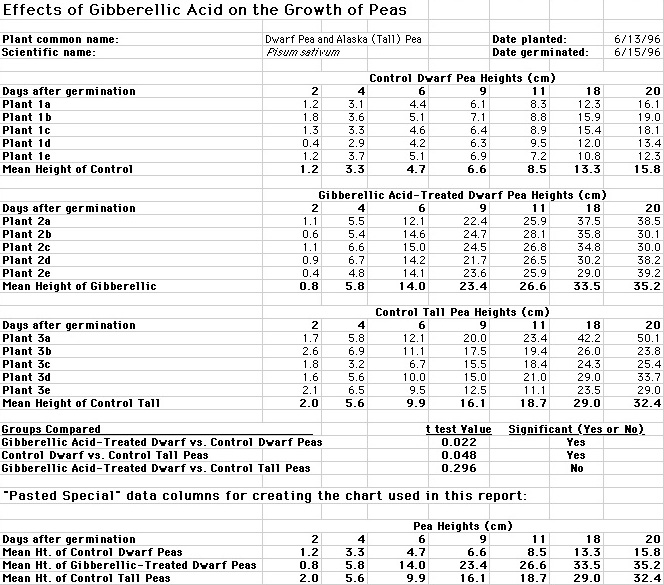I. Teacher or Student
Dana Hitchcock
II. School Name
Wheeling Jesuit University/NASA Classroom of the Future
III. E-mail Address
dana@cotf.edu
IV. Title of Experiment
The Effect of the Hormone Gibberellic Acid on the Growth of Dwarf Peas
V. Problem
How does the plant hormone gibberellic acid affect the growth rate and
dwarf character of peas?
VI. Hypothesis
Gibberellic acid will increase the growth rate of genetically dwarf peas.
VII. Equipment/Apparatus
2 gallons potting medium
3 flats with segmented inserts
Package tall pea seeds
Package dwarf pea seeds
Vial gibberellic acid paste (500 ppm)
Toothpicks
Centimeter ruler
3 clear plastic lids or cellophane
VIII. Methods/Procedures
1. Prepare soil by mixing 2 gallons of soil with 8 cups of distilled
water and let the mixture sit overnight.
2. Place the tall and dwarf seeds in 2 labeled containers of distilled
water, and let the seeds imbibe overnight.
3. Label the first flat "control dwarf peas," the second flat
"gibberellic dwarf peas," and the third "control tall peas."
4. Fill each segment with soil, and place 2 seeds at least 2 cm apart
and 5 mm deep in each segment.
5. Cover the flats with clear lids or cellophane.
6. After the seeds germinate, remove covers from flats.
7. Select 1 seed from each segment - ones that appear healthy and most
similar in height to the others in the flats. Discard the remaining seedlings.
8. Measure each seedling, and record its height to the nearest 0.5 cm.
9. Using a toothpick, smear gibberellic acid on the dwarf seedlings 2
mm thick from the soil to the tip of the plant.
10. Spray with distilled water until soil is moist throughout each flat.
11. Place flats under fluorescent or gro-lights.
12. Every second or third day, measure the plants, and record the date
and height of each plant. Note any changes in appearance of the plants (color,
branching, etc.). Water the plants before replacing under the lights.
IX. Results
1. Tables/Spreadsheets

2. Graphs

3. Brief summary of the data table and graph
According to our results, at 20 days after germination, the control dwarf
peas only showed an average height of 15.8 cm, while the gibberellic acid-treated
group of dwarf peas had an average height of 35.2 cm. The control tall peas
had an average height of 32.4 cm. Performing a t-test on these values showed
significant differences between the control dwarf and the gibberellic acid-treated
dwarf peas (t=0.022) and between the control dwarf and the control tall
peas (t=0.048). The t-test between the control tall and the gibberellic
acid-treated dwarf peas (t=0.296) showed there is not a significant difference
between these two groups.
X. Discussion of Results
1. Significance of Results
Since the gibberellic acid-treated peas grew to a height similar to that
of the tall peas, and significantly more than the dwarf peas, the results
suggest that gibberellic acid may replace the substance genetically missing
from the dwarf peas or may otherwise enhance the growth of these peas.
Variations in the amount of gibberellic acid applied to the seedlings
may account for variations in the heights of the treated dwarf peas. Errors
of 0.5 to 3 cm may also occur in the measuring, especially when the peas
start to grow tall and twist. Temperature and light intensity under the
fluorescent lights were not measured. It is possible that differences from
one position to the next might influence growth rates.
2. Applications to Advanced Life Support (ALS) Research
It might be possible that hormonal treatment could increase the food
production in potential ALS crops. It would be interesting to measure the
growing time and food production of other dwarf species, to determine if
it might be more efficient to have dwarf species in an enclosed environment
rather than their normal, taller counterparts.
3. Future Experiments
Additional investigations on the effects of gibberellic acid may be done
such as measuring the effects of gibberellic acid on the plant weight and
leaf size, comparing the number of pea pods produced by dwarf, tall, and
gibberellic acid-treated peas, or studying the effects of gibberellic acid
on other species of plants. Another investigation could involve treating
a set of tall pea plants with gibberellic acid to see if the growth rates
of the treated group increases beyond that of a control tall group.
Conclusion
The data support the conclusion that gibberellic acid increases the growth
rate of genetically dwarf peas. |